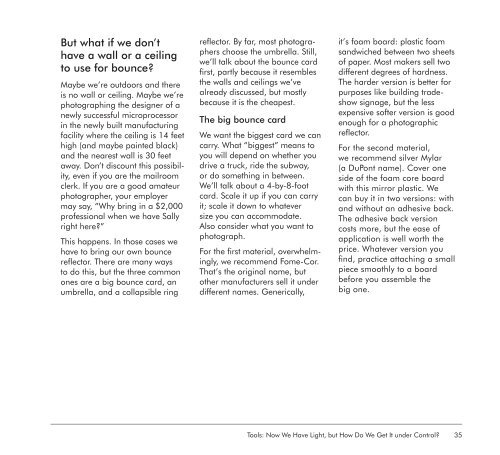Focus On Lighting Photos Focus on the Fundamentals.pdf
Create successful ePaper yourself
Turn your PDF publications into a flip-book with our unique Google optimized e-Paper software.
But what if we d<strong>on</strong>’t<br />
have a wall or a ceiling<br />
to use for bounce?<br />
Maybe we’re outdoors and <strong>the</strong>re<br />
is no wall or ceiling. Maybe we’re<br />
photographing <strong>the</strong> designer of a<br />
newly successful microprocessor<br />
in <strong>the</strong> newly built manufacturing<br />
facility where <strong>the</strong> ceiling is 14 feet<br />
high (and maybe painted black)<br />
and <strong>the</strong> nearest wall is 30 feet<br />
away. D<strong>on</strong>’t discount this possibility,<br />
even if you are <strong>the</strong> mailroom<br />
clerk. If you are a good amateur<br />
photographer, your employer<br />
may say, “Why bring in a $2,000<br />
professi<strong>on</strong>al when we have Sally<br />
right here?”<br />
This happens. In those cases we<br />
have to bring our own bounce<br />
reflector. There are many ways<br />
to do this, but <strong>the</strong> three comm<strong>on</strong><br />
<strong>on</strong>es are a big bounce card, an<br />
umbrella, and a collapsible ring<br />
reflector. By far, most photographers<br />
choose <strong>the</strong> umbrella. Still,<br />
we’ll talk about <strong>the</strong> bounce card<br />
first, partly because it resembles<br />
<strong>the</strong> walls and ceilings we’ve<br />
already discussed, but mostly<br />
because it is <strong>the</strong> cheapest.<br />
The big bounce card<br />
We want <strong>the</strong> biggest card we can<br />
carry. What “biggest” means to<br />
you will depend <strong>on</strong> whe<strong>the</strong>r you<br />
drive a truck, ride <strong>the</strong> subway,<br />
or do something in between.<br />
We’ll talk about a 4-by-8-foot<br />
card. Scale it up if you can carry<br />
it; scale it down to whatever<br />
size you can accommodate.<br />
Also c<strong>on</strong>sider what you want to<br />
photograph.<br />
For <strong>the</strong> first material, overwhelmingly,<br />
we recommend Fome-Cor.<br />
That’s <strong>the</strong> original name, but<br />
o<strong>the</strong>r manufacturers sell it under<br />
different names. Generically,<br />
it’s foam board: plastic foam<br />
sandwiched between two sheets<br />
of paper. Most makers sell two<br />
different degrees of hardness.<br />
The harder versi<strong>on</strong> is better for<br />
purposes like building tradeshow<br />
signage, but <strong>the</strong> less<br />
expensive softer versi<strong>on</strong> is good<br />
enough for a photographic<br />
reflector.<br />
For <strong>the</strong> sec<strong>on</strong>d material,<br />
we recommend silver Mylar<br />
(a DuP<strong>on</strong>t name). Cover <strong>on</strong>e<br />
side of <strong>the</strong> foam core board<br />
with this mirror plastic. We<br />
can buy it in two versi<strong>on</strong>s: with<br />
and without an adhesive back.<br />
The adhesive back versi<strong>on</strong><br />
costs more, but <strong>the</strong> ease of<br />
applicati<strong>on</strong> is well worth <strong>the</strong><br />
price. Whatever versi<strong>on</strong> you<br />
find, practice attaching a small<br />
piece smoothly to a board<br />
before you assemble <strong>the</strong><br />
big <strong>on</strong>e.<br />
Tools: Now We Have Light, but How Do We Get It under C<strong>on</strong>trol? 35



